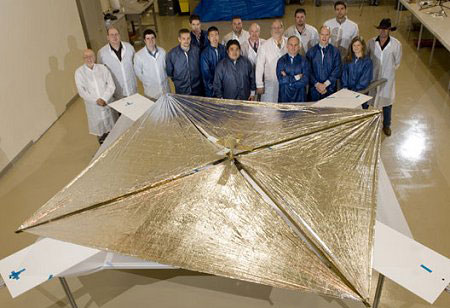NASA Solar Sail Satellite May Not Have Ejected from Mothership After All

A small NASA satellite carrying a folded-up solar sail may not have ejected from its mothership earlier this week after all, the space agency announced late Friday (Dec. 10).
NASA had reported that NanoSail-D, which is about the size of a loaf of bread, successfully ejected from the FASTSAT satellite in low-Earth orbit in the early hours of Dec. 6. But the space agency released a status update today (Dec. 10) saying that now they're not so sure.
"At this time, it is not clear that NanoSail-D ejected from the Fast, Affordable, Science and Technology Satellite (FASTSAT) as originally stated on Monday, Dec. 6," the statement reads. "At the time of ejection, spacecraft telemetry data showed a positive ejection as reflected by confirmation of several of the planned on orbit ejection sequence events. The FASTSAT spacecraft ejection system data was also indicative of an ejection event."
However, NanoSail-D was supposed to unfurl its 100-square-foot solar sail three days after ejection, and mission scientists can't confirm that this has happened. They're having trouble communicating with the tiny satellite, officials said.
"NanoSail-D was scheduled to unfurl on Dec. 9 at 12:30 a.m., and deployment hasn't been confirmed," the statement continues. "The FASTSAT team is continuing to troubleshoot the inability to make contact with NanoSail-D. The FASTSAT microsatellite and all remaining five onboard experiments continue to operate as planned."
FASTSAT launched Nov. 19 from Kodiak Island, Alaska, bearing six different science and technology demonstration payloads, including NanoSail-D.
NanoSail-D is intended to demonstrate a technology that NASA hopes will help bring decommissioned satellites down from Earth's orbit without using up valuable propellant. The idea is to use radiation from the sun as a sort of wind pushing against a thin sail to propel craft through space. [How Do Solar Sails Work?]
Get the Space.com Newsletter
Breaking space news, the latest updates on rocket launches, skywatching events and more!
Solar sails could help de-orbit larger satellites, the idea goes, thus helping free Earth orbit of dangerous, cluttering space junk, NASA officials have said.
Once its sail deploys, NanoSail-D is supposed to stay in low-Earth orbit from 70 to 120 days, according to NASA officials. Over time, the satellite will use the sail to de-orbit, spiraling lower and lower without using costly propellants like traditional satellites do.
NanoSail-D is not the first spacecraft to attempt to demonstrate solar-sail technology. In June, Japan's Ikaros probe deployed its solar sail, becoming the first craft to cruise through space propelled only by sunlight.
Nanosatellites like NanoSail-D, also known as cubesats, are typically launched and deployed from a mechanism that mounts directly on a launch vehicle. This is the first time NASA has mounted this mechanism on a microsatellite to eject a cubesat, agency officials said.
Join our Space Forums to keep talking space on the latest missions, night sky and more! And if you have a news tip, correction or comment, let us know at: community@space.com.

Space.com is the premier source of space exploration, innovation and astronomy news, chronicling (and celebrating) humanity's ongoing expansion across the final frontier. Originally founded in 1999, Space.com is, and always has been, the passion of writers and editors who are space fans and also trained journalists. Our current news team consists of Editor-in-Chief Tariq Malik; Editor Hanneke Weitering, Senior Space Writer Mike Wall; Senior Writer Meghan Bartels; Senior Writer Chelsea Gohd, Senior Writer Tereza Pultarova and Staff Writer Alexander Cox, focusing on e-commerce. Senior Producer Steve Spaleta oversees our space videos, with Diana Whitcroft as our Social Media Editor.









